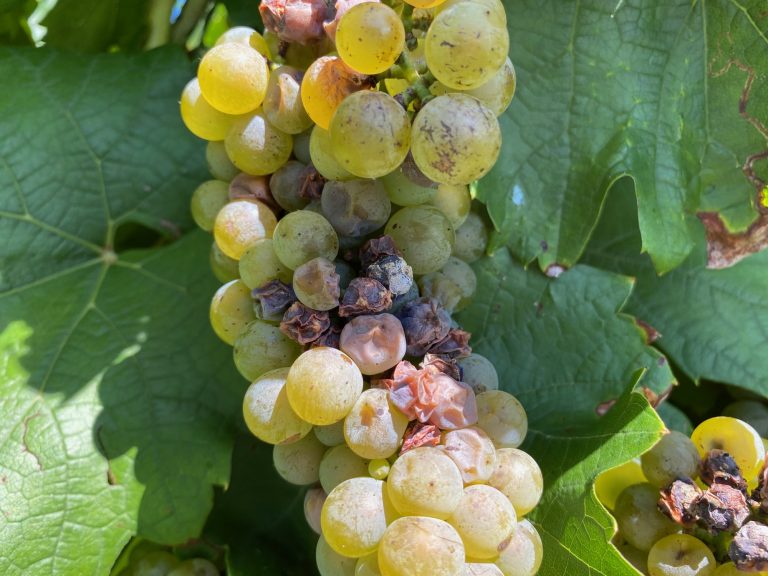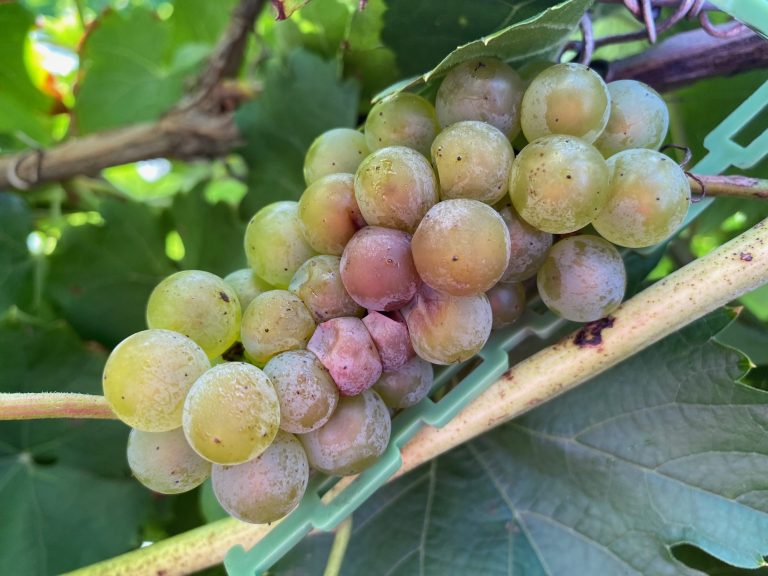Fruit rots: Late season fruit rots, including sour rot complex, botrytis and ripe rot, are major concerns in the Midwest (Figure 1). Rains this time of the year can lead to disaster. If berries split due to rain, yeasts and bacteria can quickly invade damaged fruit, which can lead to rots that attract fruit flies. Managing fruit fly populations have been determined to help slow the formation of sour rot (Figure 2). Insecticides that can be used for management include Mustang Maxx, malathion and Delegate, all of which have relatively short PHIs (post-harvest intervals) (1, 3 and 7 days, respectively). Be sure to rotate chemistries as resistance can develop. Additionally, a general sanitizer, such as Oxidate, can be used to reduce microbials responsible for the rot itself, but research has shown that managing fruit flies is key.
Figure 1. Late season fruit rot, photo by Bruce Bordelon
Figure 2. Sour rot, photo by Bruce Bordelon
Botrytis is less common than sour rot in the Midwest, but it can occur occasionally, especially in tight-clustered varieties. Unfortunately, it is difficult to control botrytis this time of year. Applications made at bloom, cluster closing and veraison are much more effective.
Ripe rot is a more recent problem that has been developing, especially in Frontenac and Marquette varieties. A veraison application of FRAV 11 containing fungicides appears to be effective at managing ripe rot, and a follow-up application can add additional protection. PHIs should be monitored closely.
Leaf diseases: We aren’t seeing much powdery and downy mildew on grapes this year, but these diseases often get established in the late season near or after harvest. In some years, these diseases may cause defoliation well before the onset of cool weather in the fall. It is important to manage these diseases even after harvest to maintain healthy foliage until frost to maximize winter hardiness. Downy can be controlled after harvest (when PHIs are no longer a concern) with phosphorous acid products, mancozeb, captan or one of the newer products such as Zampro. However, none of those fungicides will control powdery mildew. So a tank mix including one of the above with a DMI fungicide such as Rally would be a good approach. There are several other options for powdery mildew such as Torino, Endura, or Vivando, or even sulfur on sulfur-tolerant varieties.
If fruit has not been harvested yet, then options are limited to a hand full of products with short PHIs: phosphorous acid or captan for downy mildew, and Torino, Topsin-M, or sulfur for powdery mildew.
See the Midwest Fruit Pest Management Guide for more information: https://ag.purdue.edu/department/hla/extension/_docs/id-465.pdf

